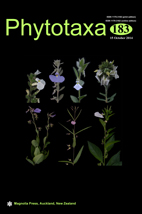Abstract
The segregate of Myriocoleopsis was firstly proposed by Schiffner (1944: 234) based on some remarkable characters, such as dimorphic stems, long male spikes, erect leafy axes arising from a creeping stolon and reduced lobules (Gradstein & Vital 1975; Reiner-Drehwald & Gradstein 1995). Hitherto a total of three species are recognized in this genus: Myriocoleopsis fluviatilis (Stephani 1895: 248) Reiner & Gradstein (1997: 639) known from Argentina, Brazil and Ecuador (Reiner-Drehwald & Gradstein 1997; Gradstein & da Costa 2003), M. gymnocolea Spruce (1884: 296) Reiner & Gradstein (1997: 640) known only from Brazil (Reiner-Drehwald & Gradstein 1997) and M. vuquangensis (Pócs & Ninh 2005: 156) Pócs (2010: 124) known only from Vietnam (Pócs 2010). Myriocoleopsis shares substantial resemblance with Cololejeunea (Spruce 1884: 291) Stephani (1891: 208) (particular subgen. Protocolea Schuster (1963: 171)) in the stem structure, absence of underleaves, lobular form, leaf margin, oil bodies and sporophytes (Gradstein & Vital 1975; Schuster 1980; Reiner-Drehwald & Gradstein 1995). Although the rigid stem and large size of Myriocoleopsis was also found in some rheophytic taxa of Cololejeunea such as subgen. Chlorolejeunea Benedix (1953: 81), it had been interpreted as adaption to similar habitats (Reiner-Drehwald & Gradstein 1995).

